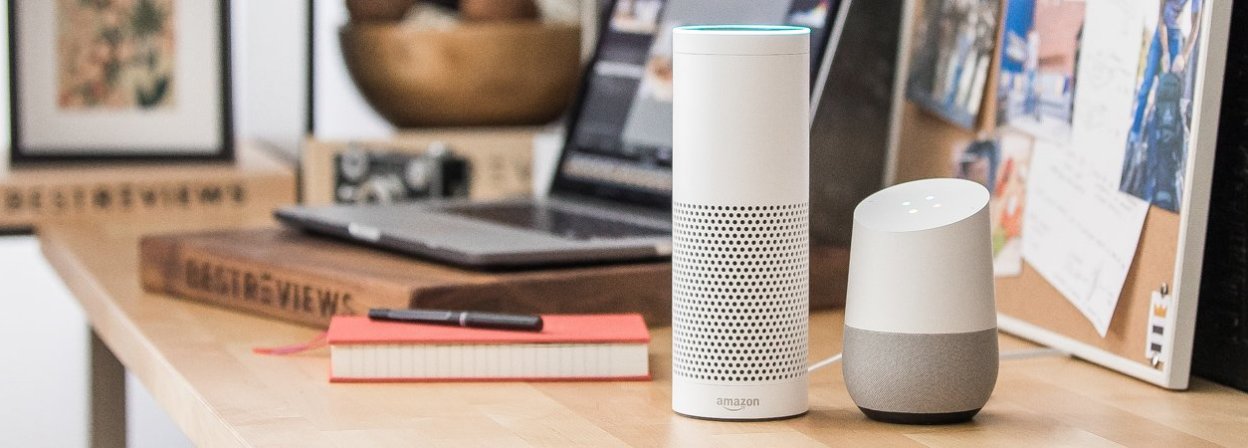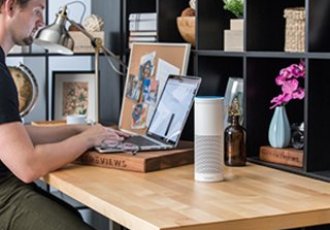BestReviews is reader-supported and may earn an affiliate commission. Details

Google Assistant's (formerly called Google Home) excellent voice recognition and broad feature set earn it our top spot.
Google Assistant's (formerly called Google Home) excellent voice recognition and broad feature set earn it our top spot.
Works great out of the box, compact size, and integrates well with the Chromecast media stick. We particularly like its ability to answer fact-based questions like: "Do I need an umbrella today?" "How long is the drive to [destination]?" and "How do I make hummus?"
Some challenges with poor WiFi signals. Struggles with some streaming music services.

We tested this device with Alexa voice assistant and a built-in hub for controlling devices around the house.
We tested this device with Alexa voice assistant and a built-in hub for controlling devices around the house.
Round speaker with great HD sound is available in 3 colors. Works with the Alexa voice assistant to control music, calendar, and smart home devices. Has mute and volume button controls. Easy to set up with an app.
May not always pick up voice recognition. Placement makes light hard to see.

The Echo Show's screen comes in handy when the answer you want involves a visual.
The Echo Show's screen comes in handy when the answer you want involves a visual.
The added screen is particularly helpful for viewing photos, using a calendar, or watching a YouTube video. Compatible with additional smart home devices.
The Echo Show is bigger, and in daily use we find that we don't use the monitor very much.

After going through an intensive research process to narrow down our short list of top products in this space, we tested the Amazon Echo (4th Gen) to be sure that it’s worthy of our recommendation. Guided by experts, we spend hours looking into the factors that matter and test to verify manufacturer claims.

If you’re looking for the two most powerful names in the tech world right now, Google and Amazon belong near the top of the list. Products from these two companies play significant roles in our everyday lives. With technology giants being so pervasive in your daily life, you might wonder what more they could possibly offer. One answer: active personal assistance. Why work through your laptop or phone to get the information you want and services you need, when you can simply talk to a device on your shelf? Ask about the day’s weather, start or stop your music, or set a timer for the oven, all with just your voice and your personal assistant. Luckily there is no requirement to know how to become a voice actor yourself for using the device!
If you’re in the market for a personal assistant, and you’re debating between Google Home and Amazon Echo, please refer to the table above for a contrast of primary features. If you’d like to learn more about personal assistant devices and how to compare them, read on to our shopping guide.

A personal assistant device offers a range of cool functions and capabilities. Regardless of which device you buy, the basic functionality boils down to this: the device, which is small enough to easily carry around, sits on your desk or shelf. It connects to the internet via WiFi. You issue a voice command to the personal assistant, and the personal assistant attempts to complete a task for you.
A personal assistant contains a microphone and speaker. When you issue a command, the microphone picks up your speech, and the personal assistant software attempts to fulfill the request. The software communicates with you through the audio speaker.
The personal assistant uses its connection to the internet to handle your request. For example, you might ask the personal assistant to give you the Cardinals baseball score, to check the weather report, or to order a product for delivery. The personal assistant uses the internet to retrieve information, or can manipulate other devices in our home to perform an action you requested.
Every digital personal assistant works a little differently in terms of how they’re activated, and which tasks they can perform. Even if you aren’t familiar with Google Home, Amazon Echo, or the offshoots of those devices, you may have already used a personal assistant software. Examples include Apple’s Siri, and Microsoft’s Cortana. Amazon’s personal assistant is referred to as “Alexa,” while Google’s is simply, “Google.”
The speaker-based digital personal assistants profiled here offer quite a few helpful features for your daily life. Below, we’ve listed some of the most common features among digital personal assistants.
Both Home and Echo run from power from an electrical outlet. However, you can add a battery from a third-party manufacturer to give these devices a bit of mobility. Also, smaller, portable models with built-in batteries are available.
Digital assistants can play trivia games with you and friends. It also can keep you entertained by telling you a silly story, making animal noises, or just by answering your crazy questions.
The personal digital assistant creates paperless shopping lists. After you verbally tell the device what to include on the shopping list, the assistant sends the list to your smartphone.
If you have a payment method stored with your personal assistant, you can order products and services. You can request a ride from Uber, or order a pizza through the digital personal assistant.

Need an alarm or a countdown timer? Just ask the personal assistant to let you know when the time is expired.
Ask your personal assistant for up-to-the-minute sports scores, weather forecasts, and stock prices.
If your Smart Home software is compatible with your personal assistant brand and model, you can instruct the device to adjust your home temperature setting, set locks, or turn off lights.
You can access numerous streaming music services through your digital assistant, such as TuneIn Radio, Pandora, or Spotify. The speaker systems in Google Home and Amazon Echo aren’t perfect, but they’ll play your music at an adequate quality level.
Whether you’re asking serious or silly questions, the personal assistant will try to answer them. You also can ask the device to perform math or verify a fact. However, neither device will answer 100% of your questions. You can expect them to be able to only “understand” around half of the questions asked – but many more if you learn the phrases they respond to best.
If you already use a lot of Google features, such as Gmail, Google Calendar, Google Drive, and others, Google Home will be a great addition to your life. It merge with your Google account to access your personal information, allowing it to work more efficiently for you. The features listed below are some of the best offered by Google Home, but not by the Amazon Echo.
Using the Google search engine, Google Home does a nice job at finding information you request. Google Home’s ability to understand a question you throw at it runs at a high rate, roughly double what Echo can understand.
Have Google Home alert you to appointments you have during the day by reading your calendar entries.
If you have a Google Chromecast-enabled speaker system or TV, Google Home can connect with those devices. You control what’s on the television through Google Home commands, or send music from the cloud to the high-quality speaker system.
The Google Home device will fit on a shelf more easily than Echo. Google Home measures about 5.6 inches tall, and weighs 1.1 pounds, while Echo measures 9.3 inches tall and weighs 2.3 pounds.
If you use Amazon for shopping, Amazon Echo can access some of your personal information from your Amazon account to make ordering products a convenient, seamless process.
Echo also makes use of “Skills,” which are app-like features. With its Skills, Echo offers far more features than Google Home, although not all of Echo’s Skills will appeal to you. Here are some areas where Amazon Echo differs from Google Home.
If you want Echo to alert you to your activity progress for the day, it will make a connection with your Fitbit and read the results.
With a connection to an Ooma phone system, you can instruct Echo to make a phone call for you.
If you have a subscription to the Audible audiobook service, or if you have books stored on a Kindle, Echo will read books to you if you ask.

As mentioned earlier, the Amazon Echo allows you to purchase products through Amazon without ever sitting down at a computer. Amazon occasionally offers discounts on products bought through the Echo.
The speaker quality on the Echo will slightly outperform Google Home, although neither device has great audio quality compared to a multiple-speaker setup.
Echo has several old radio programs in its database. The entire family can gather around the Echo and listen to the broadcast, just like your grandparents used to do with their radio console.

Expect to pay $100 to $150 for the basic Amazon Echo or Google Home device. For your money, you’ll receive the speaker and a power cord.
Both companies offer miniature versions of their personal assistants. These units will save you a little bit of money, while offering a lot of the same features of their big brothers.
The Echo Dot costs about $50. It can do most of what the Echo does, but it has a poor-quality speaker. It’s also extremely compact, taking up little space on a shelf or desk.
Echo Show doesn’t save you any money, as you’ll pay around $230 for it. However it gives you a built-in screen, which can make Alexa more fun to use. You can also use it to video call friends or family.
The Mini costs about $50, putting it in direct competition with the Echo Dot. It has a much smaller speaker than Google Home, but it can perform many of the same functions as Home.

A. Unless you have a Google account and use at least some Google services, Google Home’s features probably won’t help you very much. Google Home will only work as a speaker if you don’t have a Google account. Through Google Home and a Google account, you can access your calendar and many other features.
A. Actually, Google Home and Amazon Echo have no ongoing or subscription costs. Once you pay the upfront fee, you can begin using the service. To gain the most benefit from these personal assistants, you will need to have the associated apps from Google or Amazon, but they’re free.
A. You can set up more than one account with your personal assistant, allowing everyone in the family to access his or her own information. You can verbally command the device to switch accounts, although the devices are beginning to add the ability to switch accounts based on voice recognition alone.
A. Personal assistant devices do have an active microphone at all times, unless they’re powered down. However, these devices ignore what you’re saying until you use the “wake” word. This keyword alerts the device that you’re going to make a request, so it should begin paying attention to what you’re saying. Theoretically, the device could mistake another word for the wake word and begin recording something you don’t want recorded, but this rarely occurs.
Get emails you’ll love.
Learn about the products you’re wondering if you should buy and get advice on using your latest purchases.
